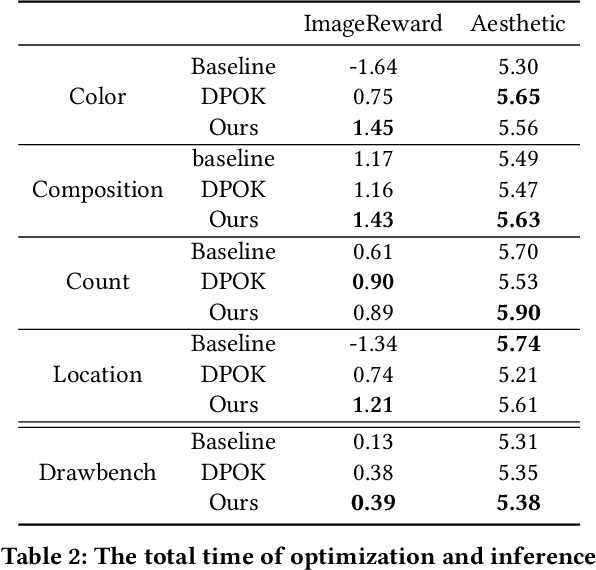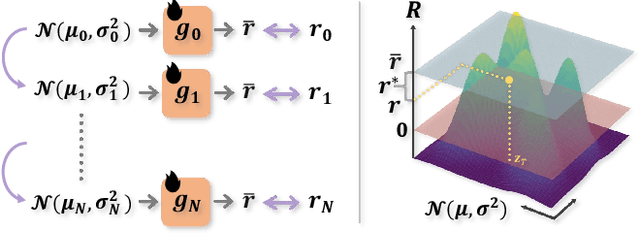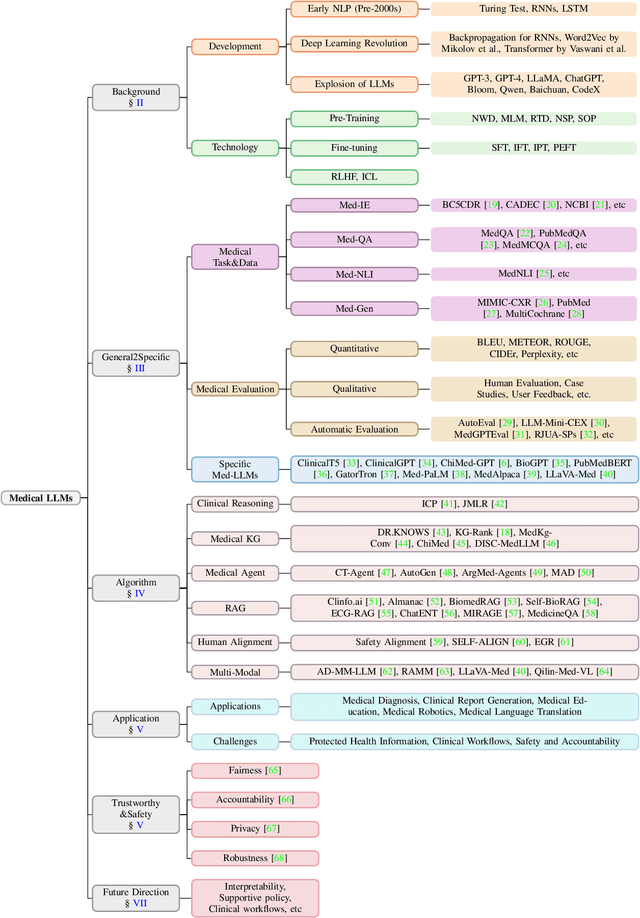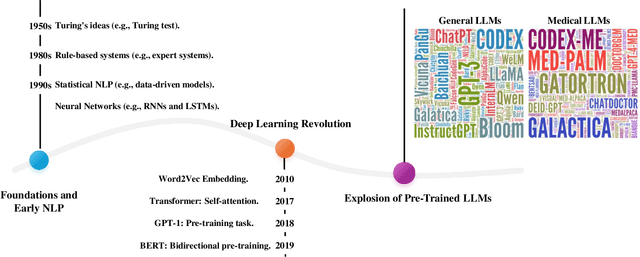Xiaoyan Yang
LMP: Leveraging Motion Prior in Zero-Shot Video Generation with Diffusion Transformer
May 20, 2025Abstract:In recent years, large-scale pre-trained diffusion transformer models have made significant progress in video generation. While current DiT models can produce high-definition, high-frame-rate, and highly diverse videos, there is a lack of fine-grained control over the video content. Controlling the motion of subjects in videos using only prompts is challenging, especially when it comes to describing complex movements. Further, existing methods fail to control the motion in image-to-video generation, as the subject in the reference image often differs from the subject in the reference video in terms of initial position, size, and shape. To address this, we propose the Leveraging Motion Prior (LMP) framework for zero-shot video generation. Our framework harnesses the powerful generative capabilities of pre-trained diffusion transformers to enable motion in the generated videos to reference user-provided motion videos in both text-to-video and image-to-video generation. To this end, we first introduce a foreground-background disentangle module to distinguish between moving subjects and backgrounds in the reference video, preventing interference in the target video generation. A reweighted motion transfer module is designed to allow the target video to reference the motion from the reference video. To avoid interference from the subject in the reference video, we propose an appearance separation module to suppress the appearance of the reference subject in the target video. We annotate the DAVIS dataset with detailed prompts for our experiments and design evaluation metrics to validate the effectiveness of our method. Extensive experiments demonstrate that our approach achieves state-of-the-art performance in generation quality, prompt-video consistency, and control capability. Our homepage is available at https://vpx-ecnu.github.io/LMP-Website/
A High-Performance Thermal Infrared Object Detection Framework with Centralized Regulation
May 16, 2025Abstract:Thermal Infrared (TIR) technology involves the use of sensors to detect and measure infrared radiation emitted by objects, and it is widely utilized across a broad spectrum of applications. The advancements in object detection methods utilizing TIR images have sparked significant research interest. However, most traditional methods lack the capability to effectively extract and fuse local-global information, which is crucial for TIR-domain feature attention. In this study, we present a novel and efficient thermal infrared object detection framework, known as CRT-YOLO, that is based on centralized feature regulation, enabling the establishment of global-range interaction on TIR information. Our proposed model integrates efficient multi-scale attention (EMA) modules, which adeptly capture long-range dependencies while incurring minimal computational overhead. Additionally, it leverages the Centralized Feature Pyramid (CFP) network, which offers global regulation of TIR features. Extensive experiments conducted on two benchmark datasets demonstrate that our CRT-YOLO model significantly outperforms conventional methods for TIR image object detection. Furthermore, the ablation study provides compelling evidence of the effectiveness of our proposed modules, reinforcing the potential impact of our approach on advancing the field of thermal infrared object detection.
* This manuscript has been accepted for publication in the International Journal for Housing Science and Its Applications (IJHSA), 2025
ABC-GS: Alignment-Based Controllable Style Transfer for 3D Gaussian Splatting
Mar 28, 2025Abstract:3D scene stylization approaches based on Neural Radiance Fields (NeRF) achieve promising results by optimizing with Nearest Neighbor Feature Matching (NNFM) loss. However, NNFM loss does not consider global style information. In addition, the implicit representation of NeRF limits their fine-grained control over the resulting scenes. In this paper, we introduce ABC-GS, a novel framework based on 3D Gaussian Splatting to achieve high-quality 3D style transfer. To this end, a controllable matching stage is designed to achieve precise alignment between scene content and style features through segmentation masks. Moreover, a style transfer loss function based on feature alignment is proposed to ensure that the outcomes of style transfer accurately reflect the global style of the reference image. Furthermore, the original geometric information of the scene is preserved with the depth loss and Gaussian regularization terms. Extensive experiments show that our ABC-GS provides controllability of style transfer and achieves stylization results that are more faithfully aligned with the global style of the chosen artistic reference. Our homepage is available at https://vpx-ecnu.github.io/ABC-GS-website.
DeepCircuitX: A Comprehensive Repository-Level Dataset for RTL Code Understanding, Generation, and PPA Analysis
Feb 25, 2025



Abstract:This paper introduces DeepCircuitX, a comprehensive repository-level dataset designed to advance RTL (Register Transfer Level) code understanding, generation, and power-performance-area (PPA) analysis. Unlike existing datasets that are limited to either file-level RTL code or physical layout data, DeepCircuitX provides a holistic, multilevel resource that spans repository, file, module, and block-level RTL code. This structure enables more nuanced training and evaluation of large language models (LLMs) for RTL-specific tasks. DeepCircuitX is enriched with Chain of Thought (CoT) annotations, offering detailed descriptions of functionality and structure at multiple levels. These annotations enhance its utility for a wide range of tasks, including RTL code understanding, generation, and completion. Additionally, the dataset includes synthesized netlists and PPA metrics, facilitating early-stage design exploration and enabling accurate PPA prediction directly from RTL code. We demonstrate the dataset's effectiveness on various LLMs finetuned with our dataset and confirm the quality with human evaluations. Our results highlight DeepCircuitX as a critical resource for advancing RTL-focused machine learning applications in hardware design automation.Our data is available at https://zeju.gitbook.io/lcm-team.
OpenLS-DGF: An Adaptive Open-Source Dataset Generation Framework for Machine Learning Tasks in Logic Synthesis
Nov 16, 2024



Abstract:This paper introduces OpenLS-DGF, an adaptive logic synthesis dataset generation framework, to enhance machine learning~(ML) applications within the logic synthesis process. Previous dataset generation flows were tailored for specific tasks or lacked integrated machine learning capabilities. While OpenLS-DGF supports various machine learning tasks by encapsulating the three fundamental steps of logic synthesis: Boolean representation, logic optimization, and technology mapping. It preserves the original information in both Verilog and machine-learning-friendly GraphML formats. The verilog files offer semi-customizable capabilities, enabling researchers to insert additional steps and incrementally refine the generated dataset. Furthermore, OpenLS-DGF includes an adaptive circuit engine that facilitates the final dataset management and downstream tasks. The generated OpenLS-D-v1 dataset comprises 46 combinational designs from established benchmarks, totaling over 966,000 Boolean circuits. OpenLS-D-v1 supports integrating new data features, making it more versatile for new challenges. This paper demonstrates the versatility of OpenLS-D-v1 through four distinct downstream tasks: circuit classification, circuit ranking, quality of results (QoR) prediction, and probability prediction. Each task is chosen to represent essential steps of logic synthesis, and the experimental results show the generated dataset from OpenLS-DGF achieves prominent diversity and applicability. The source code and datasets are available at https://github.com/Logic-Factory/ACE/blob/master/OpenLS-DGF/readme.md.
An Adaptive Open-Source Dataset Generation Framework for Machine Learning Tasks in Logic Synthesis
Nov 14, 2024



Abstract:This paper introduces an adaptive logic synthesis dataset generation framework designed to enhance machine learning applications within the logic synthesis process. Unlike previous dataset generation flows that were tailored for specific tasks or lacked integrated machine learning capabilities, the proposed framework supports a comprehensive range of machine learning tasks by encapsulating the three fundamental steps of logic synthesis: Boolean representation, logic optimization, and technology mapping. It preserves the original information in the intermediate files that can be stored in both Verilog and Graphmal format. Verilog files enable semi-customizability, allowing researchers to add steps and incrementally refine the generated dataset. The framework also includes an adaptive circuit engine to facilitate the loading of GraphML files for final dataset packaging and sub-dataset extraction. The generated OpenLS-D dataset comprises 46 combinational designs from established benchmarks, totaling over 966,000 Boolean circuits, with each design containing 21,000 circuits generated from 1000 synthesis recipes, including 7000 Boolean networks, 7000 ASIC netlists, and 7000 FPGA netlists. Furthermore, OpenLS-D supports integrating newly desired data features, making it more versatile for new challenges. The utility of OpenLS-D is demonstrated through four distinct downstream tasks: circuit classification, circuit ranking, quality of results (QoR) prediction, and probability prediction. Each task highlights different internal steps of logic synthesis, with the datasets extracted and relabeled from the OpenLS-D dataset using the circuit engine. The experimental results confirm the dataset's diversity and extensive applicability. The source code and datasets are available at https://github.com/Logic-Factory/ACE/blob/master/OpenLS-D/readme.md.
RuleAlign: Making Large Language Models Better Physicians with Diagnostic Rule Alignment
Aug 22, 2024Abstract:Large Language Models (LLMs) like GPT-4, MedPaLM-2, and Med-Gemini achieve performance competitively with human experts across various medical benchmarks. However, they still face challenges in making professional diagnoses akin to physicians, particularly in efficiently gathering patient information and reasoning the final diagnosis. To this end, we introduce the RuleAlign framework, designed to align LLMs with specific diagnostic rules. We develop a medical dialogue dataset comprising rule-based communications between patients and physicians and design an alignment learning approach through preference learning. Experimental results demonstrate the effectiveness of the proposed approach. We hope that our work can serve as an inspiration for exploring the potential of LLMs as AI physicians.
FIND: Fine-tuning Initial Noise Distribution with Policy Optimization for Diffusion Models
Jul 28, 2024



Abstract:In recent years, large-scale pre-trained diffusion models have demonstrated their outstanding capabilities in image and video generation tasks. However, existing models tend to produce visual objects commonly found in the training dataset, which diverges from user input prompts. The underlying reason behind the inaccurate generated results lies in the model's difficulty in sampling from specific intervals of the initial noise distribution corresponding to the prompt. Moreover, it is challenging to directly optimize the initial distribution, given that the diffusion process involves multiple denoising steps. In this paper, we introduce a Fine-tuning Initial Noise Distribution (FIND) framework with policy optimization, which unleashes the powerful potential of pre-trained diffusion networks by directly optimizing the initial distribution to align the generated contents with user-input prompts. To this end, we first reformulate the diffusion denoising procedure as a one-step Markov decision process and employ policy optimization to directly optimize the initial distribution. In addition, a dynamic reward calibration module is proposed to ensure training stability during optimization. Furthermore, we introduce a ratio clipping algorithm to utilize historical data for network training and prevent the optimized distribution from deviating too far from the original policy to restrain excessive optimization magnitudes. Extensive experiments demonstrate the effectiveness of our method in both text-to-image and text-to-video tasks, surpassing SOTA methods in achieving consistency between prompts and the generated content. Our method achieves 10 times faster than the SOTA approach. Our homepage is available at \url{https://github.com/vpx-ecnu/FIND-website}.
A Survey on Medical Large Language Models: Technology, Application, Trustworthiness, and Future Directions
Jun 06, 2024



Abstract:Large language models (LLMs), such as GPT series models, have received substantial attention due to their impressive capabilities for generating and understanding human-level language. More recently, LLMs have emerged as an innovative and powerful adjunct in the medical field, transforming traditional practices and heralding a new era of enhanced healthcare services. This survey provides a comprehensive overview of Medical Large Language Models (Med-LLMs), outlining their evolution from general to the medical-specific domain (i.e, Technology and Application), as well as their transformative impact on healthcare (e.g., Trustworthiness and Safety). Concretely, starting from the fundamental history and technology of LLMs, we first delve into the progressive adaptation and refinements of general LLM models in the medical domain, especially emphasizing the advanced algorithms that boost the LLMs' performance in handling complicated medical environments, including clinical reasoning, knowledge graph, retrieval-augmented generation, human alignment, and multi-modal learning. Secondly, we explore the extensive applications of Med-LLMs across domains such as clinical decision support, report generation, and medical education, illustrating their potential to streamline healthcare services and augment patient outcomes. Finally, recognizing the imperative and responsible innovation, we discuss the challenges of ensuring fairness, accountability, privacy, and robustness in Med-LLMs applications. Finally, we conduct a concise discussion for anticipating possible future trajectories of Med-LLMs, identifying avenues for the prudent expansion of Med-LLMs. By consolidating above-mentioned insights, this review seeks to provide a comprehensive investigation of the potential strengths and limitations of Med-LLMs for professionals and researchers, ensuring a responsible landscape in the healthcare setting.
Towards Automatic Evaluation for LLMs' Clinical Capabilities: Metric, Data, and Algorithm
Mar 25, 2024



Abstract:Large language models (LLMs) are gaining increasing interests to improve clinical efficiency for medical diagnosis, owing to their unprecedented performance in modelling natural language. Ensuring the safe and reliable clinical applications, the evaluation of LLMs indeed becomes critical for better mitigating the potential risks, e.g., hallucinations. However, current evaluation methods heavily rely on labor-intensive human participation to achieve human-preferred judgements. To overcome this challenge, we propose an automatic evaluation paradigm tailored to assess the LLMs' capabilities in delivering clinical services, e.g., disease diagnosis and treatment. The evaluation paradigm contains three basic elements: metric, data, and algorithm. Specifically, inspired by professional clinical practice pathways, we formulate a LLM-specific clinical pathway (LCP) to define the clinical capabilities that a doctor agent should possess. Then, Standardized Patients (SPs) from the medical education are introduced as the guideline for collecting medical data for evaluation, which can well ensure the completeness of the evaluation procedure. Leveraging these steps, we develop a multi-agent framework to simulate the interactive environment between SPs and a doctor agent, which is equipped with a Retrieval-Augmented Evaluation (RAE) to determine whether the behaviors of a doctor agent are in accordance with LCP. The above paradigm can be extended to any similar clinical scenarios to automatically evaluate the LLMs' medical capabilities. Applying such paradigm, we construct an evaluation benchmark in the field of urology, including a LCP, a SPs dataset, and an automated RAE. Extensive experiments are conducted to demonstrate the effectiveness of the proposed approach, providing more insights for LLMs' safe and reliable deployments in clinical practice.
 Add to Chrome
Add to Chrome Add to Firefox
Add to Firefox Add to Edge
Add to Edge